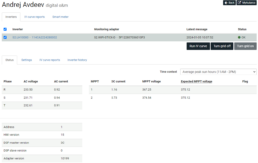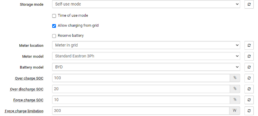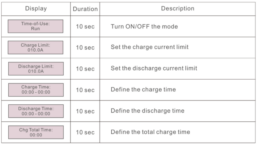Digital O&M settings
In the Helios PV system > “Asset management” > “Digital O&M” you can check the status, voltages, and currents of a chosen inverter.

In the “Settings” tab you can read and change settings, in the picture the relevant settings for a battery system:

Autarco inverters offer a variety of storage mode settings to meet customer needs. Alongside a variety of different working modes:
Auto mode (Default):
The recommended storage mode, is also called “Self-use”, or “Self-consumption” mode. When selected, the generated power is used in the following order,
- Meet household load
- Meet battery charging needs (store excess PV in batteries)
- Surplus power is fed to the grid
Priorities:
PV power using Priority: Load > Battery > Grid
Load support Priority: PV > Battery > Grid
Time of use mode:
Only to be used when running the hybrid inverter under dynamic energy contracts or manual control of the battery charging/discharging. In other words, when the users know exactly when to charge and discharge the battery, for example, based on energy prices and their energy consumption schedule.
In normal usage, set this mode OFF. “Time of use” mode is for customizing when the battery is allowed to charge and discharge power, and at which rate. It is established by setting a current (amperage). If this mode is turned on, the inverter will only use this schedule to determine when to charge and discharge the battery.

Off-grid mode
Suitable for independent PV systems that want to operate without / lack a connection to the grid. When there is sufficient sunlight, the PV will give priority to the use of the load, and the remaining power will be stored in the battery. When there is not enough sunlight, the battery will supply power to the load.
In conjunction with storage modes, Autarco inverters can be operated via several working modes, meeting the power supply requirements of different applications.
| Working mode | Working logic | Application scenario |
| Self-use mode |
|
Self-use scenarioSelf-use frequency is
higher than 90% |
| Feed-in-priority mode |
|
Grid-connected areas
With subsidies |
| Off-grid mode | Passive start; When the grid is lost, or not available, the inverter passively enters off-grid mode, and the backup port outputs in pure off-grid mode. | Areas without grid |
Allow charging from the grid
ATTENTION! For the health of the battery, this setting must be switched ON.
If “Allow charging from grid” is turned on, it does not mean the inverter will always use the grid to charge the batteries. The inverter will use grid power to charge the battery only under two circumstances:
- SOC has dropped to the “Force Charge SOC”.
- There is not enough available PV power during the charging window of “Time of use mode” to meet the current rate that is established.
Reserve battery
Maintains minimum battery SOC.
Mostly used in countries where the grid is often failing, this feature helps maintain a minimum SOC in batteries.
Meter Control
For “Meter location” select “Meter in grid”, as it aligns with how consumption is calculated in myAutarco App.
“Meter model” allows us to define the meter brand and type that has been installed. If no meter is installed, choose “No meter mode”.

Important Battery settings:
- “Battery model” allows us to select a battery brand. Select “No Battery” if that is the case.
- “Over Charge SOC” (70% ~ 100%, default 100%). Sets the upper limit of the operating SOC.
- “Over Discharge SOC” (10%~40%, default 20%)
The inverter will not discharge the battery below the OverDischarge SOC.
Battery self-discharge is unavoidable, SOC may go lower than the OverDischarge limit if the battery can’t get charged for a long period of time. - “Force Charge SOC” (5% ~ OverDischg SOC, default 10%)
To prevent the battery going into sleep mode; when the ForceCharge SOC is reached, the inverter will charge the battery using the power from either PV or Grid (If charging from Grid is allowed). - “Force Charge Limitation” (300W ~ nominal power, recommended 500W)
Set the battery charge power limit when the inverter operates under forced charge conditions.
ATTENTION!
For the health of the battery, it’s important that the battery stays charged, at least above 10%. When OverDischg SOC (20%) is reached, the inverter will stop the battery from supporting the load. The battery will discharge itself very slowly down to the ForceCharge SOC (10%) in a few weeks. When this level is reached and if there is no PV available, a forced charge from the Grid is necessary, this setting must be enabled in the inverter.
To provide a safe and healthy battery operating range, ensure that OverDischg SOC (20%), ForceCharge SOC (10%), Force Charge Limitation (500W), and “Allow charging from grid” have been set.
Still need help? Please raise a case in Helios
